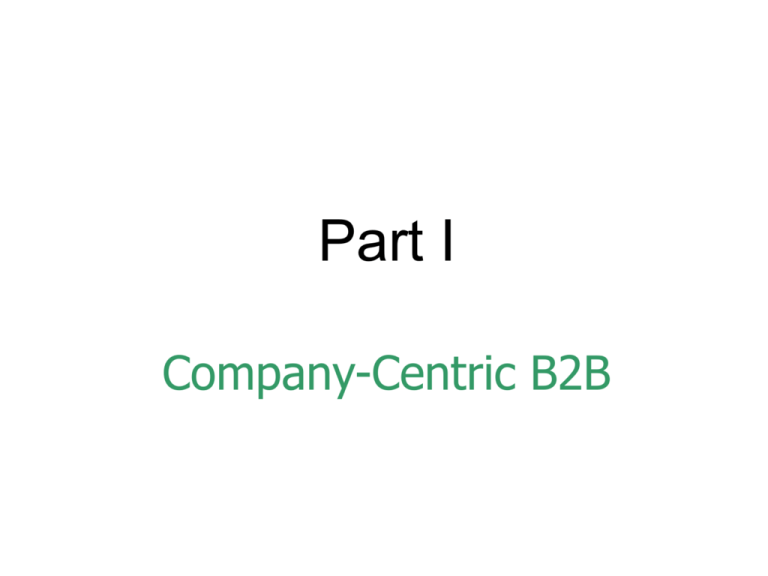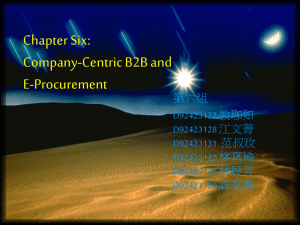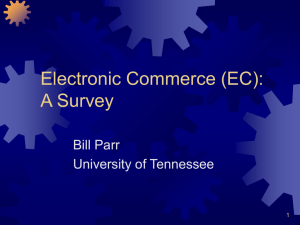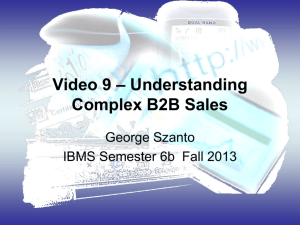Chapter 6 Company
advertisement

Part I Company-Centric B2B Concepts and Characteristics of B2B EC (cont.) – How is B2B conducted? • • • • Directly between buyer and seller Via an online intermediary Along the supply chain With or without intermediaries – Types of transactions • Spot buying —determined by dynamic supply and demand • Strategic sourcing —long term contracts Figure 6-1 B2B Supply Chain Concepts and Characteristics of B2B EC (cont.) • Supply chain relationships (sharing materials, process information and knowledge worker assets) – Interrelated subprocesses and roles • • • • Acquisition of materials Processing products and services Moving to distributors Purchase by consumer Concepts and Characteristics of B2B EC (cont.) • Entities of B2B EC – Selling company —marketing management perspective – Buying company —procurement management perspective – Electronic intermediaries —optional third party directory service provider (scope of service may be extended to order fulfillment) – Trading platforms —pricing and negotiation protocol (auctions, reverse auctions) Concepts and Characteristics of B2B EC (cont.) • Entities of B2B EC (What are they sharing?) – Payment services —mechanism for transferring money to sellers – Logistics providers —logistics to complete transaction (packaging, storage, delivery) – Network platforms —Internet, VAN, intranet, extranet (and protocols) – Back-end integration —connecting to ERP systems, databases, functional applications Concepts and Characteristics of B2B EC (cont.) Information processed in B2B • • • • • Product Customer Supplier Product process Transportation • • • • • Inventory Supply chain Competitor Sales and marketing Supply chain process and performance Benefits • Electronic intermediaries in B2B – Consumers and business may share intermediaries – Businesses may use different intermediaries with different suppliers • Benefits of B2B models – – – – – – Eliminate paper-based systems Expedite cycle time Reduce errors Increase employee productivity Reduce costs Increase customer service and partnership management B2B Models • Company-centric models – Sell-side marketplace (one-to-many) – Buy-side marketplace (many-to-one) • Many-to-many marketplaces—the exchange – Buyers and sellers meet to trade • Trading communities • Trading exchanges • Exchanges B2B Models (cont.) • Other B2B models and services – For the purpose of selling – For the purpose of buying – Value chain integrators – Value chain service providers – Information brokers • Vertical vs. horizontal marketplaces – Vertical—one industry or industry section – Horizontal—service or product used in several types of industries B2B Models (cont.) • Virtual service industries in B2B – Travel and tourism services – Real estate – Electronic payments – Online stock trading – Online financing – Other online services Sell-Side Marketplace Architecture Sell-Side Marketplaces:One-toMany • Virtual sellers—Bigboxx.com.hk of Hong Kong – B2B office supply retailer services (corporate clients) – Goal—sell products in various SE Asian countries (many products 10,000 items, many suppliers -300) – Company portal • Browse online catalogs • Use search engines • Payments (many types available) – Delivery • Owns trucks and warehouses • Delivery scheduled online – Same day (within an hour) – Specifically scheduled time • Ordering system integrated with SAP-based back-office system Sell-Side Marketplaces: One-to-Many (cont.) • Virtual sellers—Bigboxx.com.hk of Hong Kong (cont.) – Value-added services • • • • • Track status of order Check stock availability Promotions Customized prices Group accounts and central approval—for businesses with multiple branches • Standing orders automatically activated • Large number of reports and data available Sell-Side Marketplaces: One-to-Many (cont.) • Customer service – General Electric • 20 million calls/year about appliances • Reduced cost of each call from $5 to $0.20 – Milacron, Inc. • Site contains 55,000 products – Easy to use – Securely handles selection, purchase, application • Technical service—expanded to provide a higher level of service than previously available at the site Sell-Side Marketplaces: One-to-Many (cont.) Direct sales from catalogs Configuration and customization Efficient customization for direct sales Business customers Customize products Receive price quote Submit order Successful cases • Dell • Intel • IBM • Cisco Sell-Side Marketplaces: One-to-Many (cont.) • Direct sales from catalogs – Benefits • Reduces costs (to buyers and sellers) and errors during the process • Speeds up order cycle • Ability to customize products • Offer different prices to different customers – Limitations • Channel conflicts with distribution systems • High cost when traditional EDI used • Large number of business partners is needed to justify system Selling Side: Auctions • Forward auctions—quick disposal of items – Revenue generation – Member acquisition and retention—bidding transactions result in additional registered members • Selling from own site when: – Large companies that conduct auctions frequently don’t benefit from using intermediaries – E-marketplace already in use, cost of adding auction not too high • Using intermediaries when: – No resources required, control auction information – Service: researching, searching and reporting on auction activities Selling Side • Billing and collection – Automatic calculation of shipping weights and charges – Payment—encrypted credit card data – Billing information—easily downloaded into existing systems – Successful if: • Sufficient number of loyal customers • Products well known • Price not major purchasing criteria Sell-Side Case: CISCO Connection Online (CCO) • Benefits—saves the company $363 million per year in: – – – – Technical support Human resources Software distribution Marketing material • Customer service—Cisco Connection online • Online ordering—Internet Product Center builds virtually all products to order • Order status—customer tools for finding answers to order status inquiries Cisco Connection Online (CCO) • Benefits to Cisco – Reduced operating costs for order taking – Enhanced technical support and customer service – Reduced technical support staff cost – Reduced software distribution costs – Lead times reduced fro 4-10 days to 2-3 days • Benefits to customers – Quick order configuration – Immediate cost determination – Collaboration with Cisco staff Sell-Side Intermediaries • Marshall Industries - multinational distributor of electronic components • Products and services • MarshallNet, portal, PartnerNet, NetSeminar, etc • Strategy • Continuous improvement, Team-based organization, flat hierarchy, decentralized decision making, Profit sharing w/employees. • CRM highly promoted, Web-based services • EC initiatives supported by: – Changing internal organization – Changing internal procedures Sell-Side Intermediaries (cont.) • Boeing’s PART – Intermediary between the airlines and parts’ suppliers – Provides a single point of online access through which airlines and parts’ providers can access the data needed – Goal: provide its customers with one-stop shopping for online parts and maintenance information and ordering capability Sell-Side Intermediaries (cont.) • Boeing’s PART – Spare parts business using traditional EDI • Mechanic tells purchasing department parts are needed, purchase is approved, purchase is made • Large airlines connect to Boeing's VAN • Boeing finds part and delivers – Debut of PART on the Internet • Encourages customers to order parts electronically—cheap, easy, fast • 50% of customers using Internet within first year Sell-Side Intermediaries (cont.) Benefits of Boeing PART online • New sales opportunities – Benefits to Boeing’s customers • Increased productivity—less time searching for information • Reduced costs—delays at gate reduced because all information is available • Increased revenues—faster service provides time savings • Customer service online reduces (calls on orders, data entry) – Portable access to technical drawings/support • Boeing On Line Data (BOLD) provides availability to: – Engineering drawings – Manuals – Catalogs – Other technical information • Portable Maintenance Aid (PMA)—solves maintenance problems Buy Side: One-from-Many, E-Procurement • Purchasing agents (buyers) – Direct (materials) purchasing • Use of material is scheduled • Not a shelf item – Indirect (materials) purchasing • MROs (Maintenance,Repair,Operations) • Nonproduction materials • Inefficiencies in procurement management of indirect materials Figure 6-3 A Traditional Purchasing Process Flow Source: ariba.com, February 2001. Buy Side: One-from-Many, E-Procurement (cont.) • Innovative procurement management – Innovative purchasing as strategic approach to increase profit margins – Web facilitation includes: • • • • • Electronic tendering Volume purchasing Aggregating supplier catalogs at buyer’s site Group purchasing Others Buy Side: One-from-Many, E-Procurement (cont.) • Goals of procurement reengineering – Increase purchasing agent productivity – Lower purchasing prices of items (through standardization, and consolidation of buys) – Improve information flow and management – Minimize maverick (unplanned) buying from non-contract vendors – Improve payment process – Streamline purchasing process to make it: • Simple • Fast Buy Side: One-from-Many, E-Procurement (cont.) • Goals of procurement reengineering (cont.) – Reduce administrative processing cost per order – Find new suppliers and vendors to provide faster/cheaper goods and services – Integrate procurement process with budgetary control, efficiently and effectively – Minimize human errors in buying or shipping process Figure 6-4 Buy-Side B2BMarketplace Architecture Buy Side: One-from-Many, E-Procurement (cont.) • Direct vs. indirect sourcing – Tools to automate purchasing goods • Direct or mission critical – 80% of manufacturer’s expenditure – Long-term relationship with vendor of known quality goods – Tight integration with suppliers along supply chain • Indirect—use of public exchanges for indirect sourcing Buy Side: Reverse Auctions • Pre-Internet Reverse auction process – Prepare description of product to be produced – Announce project via ads, mail, telephone – Send detailed information to interested vendors – Vendors prepare proposals – Bidders submit document proposals – Proposals evaluated – Problems: • Laws • Expensive • Errors Buy Side: Reverse Auctions (cont.) • Web-based reverse auction process – Buyers prepare bidding project information – Buyers post project on portal – Identify potential suppliers – Invite suppliers to bid – Suppliers download project information – Suppliers submit electronic bid – Reverse auction in real-time, or it can take a few days – Buyers evaluate and award contract Buy Side: Reverse Auctions (cont.) • Web-based reverse auction process – Benefits: • Electronic process is faster • Administratively much less expensive • Enables location of cheapest possible products Aggregating Catalogs • Aggregating suppliers’ catalogs: an internal marketplace – Maverick buying to save time leads to high prices – Aggregating all approved suppliers’ catalogs in one place • Reduced number of suppliers – Buyers at multiple corporate locations • Fewer and remote suppliers • Larger quantity/lower costs Group Purchasing • Group purchasing—orders from several buyers are aggregated – Internal aggregation • Economy of scale • Reduced transaction processing cost – External aggregation • Aggregating demand online • Putting together orders from multiple buyers to make large volumes/lower costs Electronic Bartering • Electronic bartering – Exchange of goods or services without the use of money – Exchange a surplus for other need – Bartering exchange • Submit surplus to exchange for points • Points used to buy what company needs – Benefits: • Faster than manually • Easier to match Collaborative Commerce (CCommerce) • Web-based systems used between and among suppliers for: – Communication – Design – Planning – Information sharing – Information discovery Suppliers Extranet: Hudson Dayton Collaborative Commerce (C-Commerce) (cont.) • Reduce design cycle time by connecting suppliers: Adaptec, Inc. – Microchip manufacturer supplying electronic equipment makers • Outsources manufacturing tasks • Delivery times exceeded their competitors – Solution to the problem • Extranet and enterprise-level supply chain integrated software • Significantly reduced order-to-product delivery time Collaborative Commerce (C-Commerce) (cont.) Reduce product development time by connecting suppliers: Caterpillar, Inc. Heavy machinery manufacturer uses extranet Request for customized component directly to designers and suppliers ship to buyers Connect engineering and manufacturing division with worldwide • Suppliers • Distributors • Overseas • Factories • Customers Collaborative Commerce (C-Commerce) (cont.) • Other examples of c-commerce – Tricon Restaurant International—global brand marketing management – RE/MAX—real estate franchiser improved communication and collaboration between independent owners – Marriott International—links corporations, franchising partners, suppliers, customers – Nygard of Canada—interorganizational collaboration Integration • • • • • • • ERP software Customer, supplier, and other databases Legacy systems Catalog (product) information Inventory systems Sales statistics Decision support systems (DSS) and SCM applications Integration (cont.) • Integration with existing information systems – Issues in integrating with back-end information systems: • • • • • Intranet-based work flow Database management systems (DMBS) Application packages ERP Back-end sell-side integration works for sellers but not buyers and vice versa Integration (cont.) • Integration with business partners – Easy integration with one company-centric side – Not easy to integrate for many buyers or sellers – Need buyer owned shopping cart that can interface with back-end information systems Implementation Issues • Justification and prioritization – Must conduct cost benefit analysis of proposed projects – Include organizational impacts • Possible channel conflicts • Dealing with resistance to change due to processes reengineering – Cost-benefit analysis related to: • Finding B2B opportunities • Prioritizing potential initiatives Implementation Issues (cont.) • Vendor selection – Primary vendor uses its software and procedures, adds partners as needed – Integrator mixes and matches existing products and vendors to create “best of the breed” • Affiliate programs (referral program or intermediaries) • Implementing e-procurement – Fit e-procurement into EC strategy – Review and change procurement process itself – If ERP or SCM is in place—integrate e-procurement, If not in place—BPR before implementation – Coordinate buyer’s information system with seller’s Managerial Issues • B2B marketing—sell-side marketplaces require advertisement and incentives • Which models to use and when—need for implementation strategies and prioritization • Purchase process reengineering (BPR) – Establish buy-side marketplace on its server if volume is big enough to attract major vendors – Join third-party intermediary-oriented marketplace if volume is small Managerial Issues (cont.) • Integration—trading in e-marketplaces is interrelated with logistics – Particularly true in many-to-many exchanges – Company-centric marketplaces must integrate: • Logistics • Other support services Part I (cont.) B2B Support Services modified by Judith Molka-Danielsen The Evolution of E-Marketplaces Financial B2B Services • Purchasing Cards are an advantage to big government agencies or deparments. • Electronic letters of credit (for big businesses) • Benefits to seller – Credit risk reduced – Payment highly assured – Political/country risk reduced • Benefits to the buyer – Allows negotiation of lower purchase price – Expansion of supply sources – Payment received after document inspected by issuing bank Figure 8-4 Participants and Process of Using a Purchasing Card Source: napcp.org/napcp.nsf/Cardparticipants!OpenPage. Used with permission of NAPCP. Financial B2B Services (cont.) • Payments (cont.) – Payments in B2B global trading – Venture capital to fund e-commerce initiatives – Internet incubators (show ad) – Tax calculation services • • • • DPC HotSamba Sales tax clearinghouse Taxware international – Implementing tax collection in the U.S. Financial B2B Services (cont.) • Payments (cont.) – Other financial services • • • • • Credit reporting firms New credit intermediaries broker credit risks Assurance firms guarantee quality Exchanges strike insurance deals E-credit services Order Fulfillment, Logistics, and Supply Chain Services • UPS Logistics Group • Handles outbound logistics and delivery. This is only one part of order fulfillment. See the List of Services on page 328. Solutions for EC initiatives – – – – – Tracking systems Product return systems Shipping solutions E-document exchange Customization • EC software/providers • E-services/partners Marketing and Advertisement • Advertising methods used by offline marketers – Vertical trade show – Ads in industry magazines – Salespeople call on: • Existing customers • Potential buyers • Digital advertisers – Ad server network provider – Electronic wholesalers Affiliate Programs • Affiliate programs (B2C services) – Affiliates invited to put a banner of a vendor on their sites – Consumer clicks on the banner and brings up that company’s EC site – Commission paid to affiliate if customer makes a purchase 59 © Prentice Hall, 2002 Infomediaries • Infomediary services – Collect data about consumer behavior (clickstream) – Analyze it – Repackage it (Data Mining Technology) – Sell the results • As marketing and profiling information • Purpose to increase customer loyalty – Identify likely buyers • Increased sales (Services, Market efforts) • Reduced marketing costs Other Marketing Services • Three examples of other services: – Digitalcement.com provides corporate marketing portals; builds stronger relationships with customers – Vantagenet.com free tools that help increase traffic to a company’s Web site – Businesstown.com has an online directory that enables small businesses to identify and evaluate service companies Content Generation, Syndication, Delivery, and Management (cont.) • • • • Syndication Content-delivery networks (CDNs) Catalog content Content management options – Do it yourself – Let the suppliers do it – Buy the content from an aggregator – Subscribe to a vertical exchange – Outsource to full-service Internet exchange Content Generation, Syndication, Delivery, and Management (cont.) • Content maximization and streaming services—companies provide media rich content to reach target audience – Video clips – Music – Flash media • Use content delivery solutions that do not cause “traffic jams” with slow download times (e.g., Akamai Corporation) Directory Services & Search Engines • Directory services – – – – – – – – – B2Business.net B2BToday.com Communityb2b.com A2zofb2b.com I-stores.co.uk Websteronline.com Thomasregister.com Bocal.com B2b.yahoo.com • Search engines and news aggregators – Moreover.com – Google.com – Ientry.com • Newsletters E-Communities • E-communities – Chat rooms – Bulletin boards – Personalized Web pages • B2B are basically communities of transactions – – – – Classified ads Job vacancies Announcements Industry news • E-communities connect: – – – – Personnel Partners Customers Any combination of these three • Service providers – Design of exchange portals – E-community service Partner Relationship Management (PRM) • In B2B environment the partners include: – Suppliers – Partners in joint ventures – Service providers • PRM—relies on: – – – – Trust Commitment Quality of services Continuity Strategy for e-service How much to invest in services What services to provide Other B2B Services • Trust services • Trust Trademark and domain names • Digital photos • Global business communities • Client matching • E-business rating sites • Promotion programs • Encryption sites • Web research services • Coupon-generating sites Figure 8-8 The B2X Hub Source: Compiled from “B2B Exchanges,” Internet Exchange 2000 at Keenanvision.com, April 24, 2000. Integration • Integration in e-marketplaces and exchanges – B2X hubs connect: • • • • • • All Internet business services Merchant services Exchange infrastructure Buying and selling Member enterprises Other B2X exchanges






